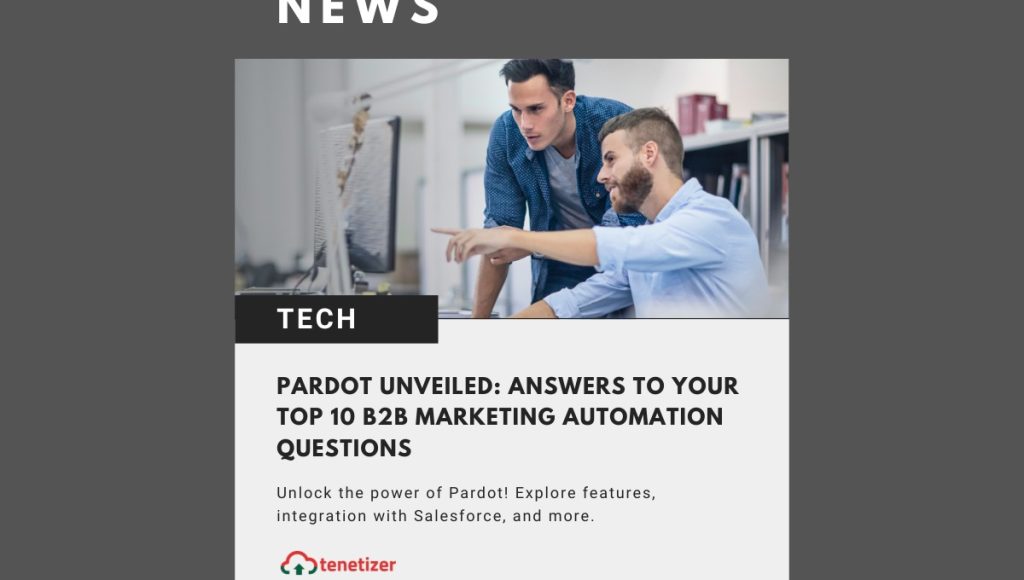Introduction:
In the ever-evolving landscape of B2B marketing, Salesforce Marketing Cloud Account Engagement, formerly known as Pardot, stands out as a go-to choice for organizations seeking a powerful marketing automation tool. In this comprehensive guide, we’ll address ten frequently asked questions about Pardot, providing insights based on real-world experience. Whether you’re a seasoned marketer or new to the Pardot platform, this guide aims to demystify Pardot and highlight its capabilities.
1. What Is Pardot and How Does It Work?
Pardot is a marketing automation solution designed to help marketers identify prospective customers most likely to convert. It achieves this by analyzing prospect data, including information submitted through forms, Salesforce CRM data, and interactions with digital marketing assets. Pardot treats each prospect as an individual, guiding them through the journey of getting familiar with a product or service at their own pace.
2. What Is Pardot Used For?
Pardot serves various purposes, including:
Email Marketing: Conducting one-off emails and automated email journeys for lead nurturing.
Forms: Capturing and enriching prospect data.
Engagement History: Compiling a log of prospect activity across online assets.
Segmentation: Splitting prospect databases into targeted audiences.
Scoring: Evaluating prospects based on engagement behavior.
Grading: Assigning grades based on alignment with the ideal customer profile.
Lead Qualification: Identifying prospects for the sales team focus.
Social Media Marketing: Posting and tracking engagement on LinkedIn, Twitter, and Facebook.
Search Marketing: Tracking keywords and SEO metrics.
Marketing Analytics: Reporting on campaign performance and marketing-influenced pipeline.
Multi-Channel Marketing: Integration with other Salesforce products and external tools.
3. What Is the Difference Between Pardot and Salesforce?
While Salesforce is the central hub for customer interactions, Pardot acts as a marketing automation add-on to Salesforce. Pardot focuses on email marketing, prospect data capture, behavior tracking, and scoring, while Salesforce manages lead and opportunity lifecycles, account data, and support case management.
4. How Does Pardot Work With Salesforce?
Pardot and Salesforce work together closely through bidirectional data sync. Pardot data syncs to Salesforce, and vice versa, exchanging information on new leads, engagement data, lead qualifications, and opportunity progress. This collaboration ensures a comprehensive view of prospect interactions, bridging the gap between marketing and sales efforts.
5. Is Pardot Owned By Salesforce?
Yes, Pardot is owned by Salesforce. Acquired in 2013 as part of the ExactTarget acquisition, Pardot became an integral part of Salesforce’s marketing solutions. The retirement of Pardot connectors to other CRMs emphasizes Salesforce’s commitment to the Salesforce-Pardot connector.
6. Can Pardot Be Used For B2C?
Initially known as a B2B marketing automation solution, Pardot has evolved to serve B2C organizations as well. While best suited for organizations with a “considered” sales cycle, Pardot can bring value to B2C marketers with high-value products or services and a thoughtful sales process.
7. Is Pardot Similar to MailChimp?
Though Pardot and Mailchimp may seem similar, key differences exist:
Pardot’s connector talks to more objects, providing a reliable sync with Salesforce.
Pardot offers advanced analytics, including Engagement History and B2B Marketing Analytics.
Segmentation in Pardot is database-centric, avoiding record duplication.
Pardot uses CRM ID, while MailChimp uses email address as the unique identifier.
8. Is HubSpot Better Than Pardot?
The comparison between HubSpot and Pardot depends on specific organizational needs:
HubSpot excels in top-of-funnel marketing and inbound strategies.
Pardot focuses on sales enablement and customer journeys for considered purchases.
Integration capabilities vary, with Pardot relying on Salesforce’s extensive platform.
Ultimately, the choice depends on the organization’s marketing objectives and preferred features.
Conclusion:
Pardot emerges as a versatile and powerful marketing automation tool, addressing a myriad of marketing needs for both B2B and B2C organizations. As businesses strive for seamless integration between marketing and sales efforts, Pardot’s tight alignment with Salesforce ensures a holistic view of customer interactions. Whether you’re a Pardot veteran or considering its implementation, this guide aims to provide clarity and insights into the world of B2B marketing automation. Contact us for further implementation details.

